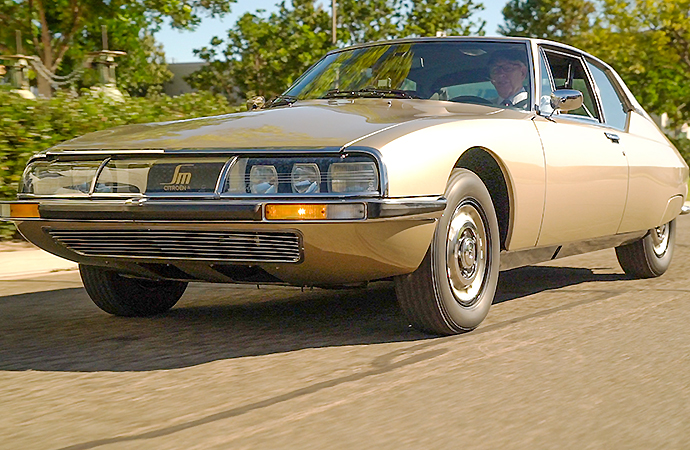Editor’s note: November is Import Month on the ClassicCars.com Journal. Get all the news you could ever need about Italian, German, English, French, Japanese and lots of other cars at our dedicated page.
A French-built car with an Italian-built V6 under the hood, the Citroen SM SC was lauded by critics and was the Motor Trend Car of the Year in 1972.
We went to the Mullin Automotive Museum in Oxnard, California to take a spin in the car nicknamed both the “Citroen Maserati” and a French supersled. Ours was a pristine example from the 1974 model year.
Given the car’s complexity and rareness, we’re not shocked Nick wasn’t allowed behind the single-spoke wheel. However, the museum was kind enough to let docent Dr. Rick Eberst take Nick around the block a few times.
Riding in the car is a like floating in a dream. The advanced hydraulic system (more on that later) irons out nearly every bump in the road. Paired with a luxurious interior and plenty of trunk room, it’s clear Citroen meant the SM to be a tourer capable of high-speed travel.
You’ve likely never seen one on this side of the Atlantic, as only a few thousand were imported and values remained low for a long time, so collectors weren’t snapping them up. However, they’ve started to turn more heads recently and one sold last year for more than $80,000.

Citroen began working on a sport variant of the already advanced Citroen DS in the early ‘60s. The DS had a radically aerodynamic design and a hydropneumatic suspension that let the driver set the ride height and offered an exceptionally smooth ride. Both were included in the SM.
Designed by Robert Opron, the SM splashed onto the scene in 1970 at the Geneva Motor Show and went on sale in Europe later that year. It was the first real effort by a French manufacturer to enter the grand routier (ground touring) class after Bugatti and other makers faded after World War II.
Prior to the SM, the most power Citroen offered was from a 140 horsepower four-cylinder engine. The French marque found its new 180 horsepower powerplant at Maserati, which was developing a new V6. The engine played a part in Citroen’s eventual, but short-lived, purchase of Maserati.
The dramatically low and long styling was very individualistic, then and now. Nothing had looked like the SM before or since, and it looks more like a concept car than a production car.
It wasn’t just the styling that people loved. In typical Citroen fashion, the front-wheel-drive SM SC was made to drive but took some getting used to. Its self-centering steering is called DIRAVI in Europe and SpeedFeel in the U.S. Basically, it’s power steering with controlled return and hydraulic action that varies based on the vehicle’s speed.
The steering wheel needs just two rotations to go from lock to lock and, if the single-spoke wheel is turned while the car is parked, it will automatically re-center itself.
Let’s talk about that single-spoke wheel for a minute: Most wheels have multiple spokes, but not this one. Citroen originally designed single-spoke wheels so drivers could better see the gauges, but it became a kind of signature design. It was used in multiple models but was eventually phased out.
Instead of a conventional brake pedal, the SM and other Citroens of that era use a large, round button that responds to foot pressure. It’s been fondly nicknamed the mushroom.
The Citroen SM wasn’t the quickest car ever made, but thanks to its highly aerodynamic body, it is capable of hitting nearly 140 mph, making it one of the fastest production vehicles of the era.
Ownership was a pricey endeavor. New SMs were priced at $11,800 in the U.S., about $2,000 more than a Cadillac Eldorado. That put it among some BMWs, Mercedes, Porsches and even Ferraris.
Unfortunately, the Maserati-designed engine developed a reputation for reliability issues. A hasty design job lead to an unideal angle between the cylinder banks, causing uneven firing. That, in turn, created vertical shaking and lumpy idle, among other issues.
Other parts – the complex timing chains, oil pump, ignition system and air-injection smog pumps on the American versions – also became problematic.
This car was made after 1973, when Citroen pulled out of the U.S. because American sales were too low to justify costs. It’s possible that fewer than 300 of this model year exist as sales tumbled amid the OPEC oil crisis.
As sales fell, the SM’s stock did as well. The plug was pulled on the car in 1975, the same year Citroen sold its stake in Maserati.





Please, there is no such word as "unideal’. "less than ideal" will cover it!
First I’ve heard of any complaints about the Maserati V-6, of which quite a few were produced for use in the Merak and Biturbo.
It BETTER be advanced as hell. It’s the ugliest thing on the road. A Mack Dump Truck has better looks.
Graduated ’78. Best street racer in Indianapolis when I was in the mix had a green/gold bass boat glitter gear-drive big block ’70 Nova, everyone called the "Slime". Owner Gino supported his Hungarian immigrant parents through his machine shop and *ahem* extracurricular activities.
They had a legit, honest to God SM.
As a 440 Mopar owning teen, I didn’t think that it was significant, but it was such a cool thing… Had no idea they were collector’s items. Now I want one- check "Highlander", the TV series; hero Duncan McLeod sports a late model DS.
Arrgh. Missed the boat again.
-R